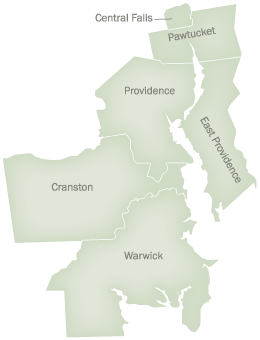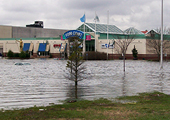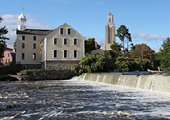
Check out the Level of Service
Memorandums for each municipality
by clicking on the map.
Introduction
In 2013, seven municipalities at the head of the Narragansett Bay began exploring regional solutions to a wide range of shared challenges including flooding, stormwater pollution, and degraded drainage infrastructure. All seven municipalities lack adequate resources to routinely maintain drainage infrastructure and to make needed infrastructure improvements to address stormwater problems and to fully comply with stormwater permit requirements. Faced with similar challenges and more stringent stormwater regulations, many communities across the country have established stormwater management districts to serve as an equitable funding source to tackle these challenges.
With funding from RI Department of Environmental Management, the seven municipalities (Central Falls, Cranston, East Providence, North Providence, Providence, Pawtucket and Warwick) came together to explore the creation of a regional stormwater utility as a coordinated approach to provide a long term, sustainable solution to stormwater management. The Phase I Study, completed in 2014, provided a planning level assessment of the feasibility of a regional stormwater utility district for the seven municipalities. Six of the seven communities, and the RI Department of Transportation (RIDOT) are now entering Phase II, which will define the utility’s scope and governance, and provide detailed guidance on the steps to implement a regional stormwater management district. At the conclusion of Phase II, municipalities will determine whether to proceed to Phase III, which would establish the management district. Visit the About the Study page for more information.
What is a Stormwater Management District?
A stormwater management district creates a separate fund designated for stormwater services. It is to stormwater what a sewer utility is to sewage, and a water utility is to drinking water. Stormwater utilities generate revenue through user fees that are based upon the amount of stormwater generated on a property. Stormwater fees are seen as more equitable than property taxes for funding stormwater services because fees are proportional to their stormwater contribution, and not on the value of the property. Today, there are over 2000 stormwater utilities nationwide that fund municipal stormwater services.
Benefits

March 2010 flood at Warwick Mall

Benefits of a regional stormwater management district include:
- A stable, adequate, flexible, and equitable source of funding
- Consistent flood mitigation efforts across the region
- An effective means of addressing water quality problems that span across municipal borders
- A cost-effectiveness approach to address technical needs and services
- The ability to address management issues and infrastructure problems of interconnected systems






 Central Falls
Central Falls Cranston
Cranston
 Providence
Providence Pawtucket
Pawtucket Warwick
Warwick RIDEM
RIDEM NBC
NBC RIDOT
RIDOT